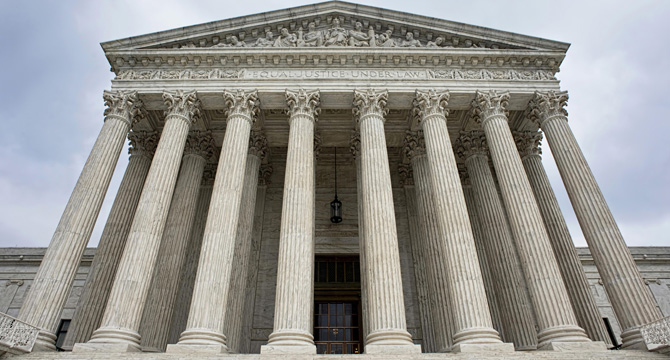
Today in Oil States v. Greene’s Energy, the Supreme Court upheld the constitutionality of IPR proceedings, finding that they are a permissible second review of patents conducted by the administrative agency that issues them and not a violation of the right of a property owner to have adjudication of property rights by an Article III court and also comply with the 7th Amendment. The decision was issued by a majority of Justices Thomas, Ginsburg, Breyer, Alito, Sotomayor and Kagan. Justices Breyer, Ginsburg and Sotomayor also issued a concurring opinion, while Justices Roberts and Gorsuch dissented.
The holding is summarized in the following syllabus reproduced from the slip opinion:
1. Inter partes review does not violate Article III. Pp. 5–17.
(a) Under this Court’s precedents, Congress has significant latitude to assign adjudication of public rights to entities other than Article III courts. Executive Benefits Ins. Agency v. Arkison, 573 U. S. ___, ___. Inter partes review falls squarely within the public-rights doctrine. The decision to grant a patent is a matter involving public rights. Inter partes review is simply a reconsideration of that grant, and Congress has permissibly reserved the PTO’s authority to conduct that reconsideration. Pp. 5–10.
(i) The grant of a patent falls within the public-rights doctrine. United States v. Duell, 172 U. S. 576, 582–583. Granting a patent involves a matter “arising between the government and others.” Ex parte Bakelite Corp., 279 U. S. 438, 451. Specifically, patents are “public franchises.” Seymour v. Osborne, 11 Wall. 516, 533. Additionally, granting patents is one of “the constitutional functions” that can be carried out by “the executive or legislative departments” without “‘judicial determination.’” Crowell v. Benson, 285 U. S. 22, 50–51. Pp. 7–8.
(ii) Inter partes review involves the same basic matter as the grant of a patent. It is “a second look at an earlier . . . grant,” Cuozzo Speed Technologies, LLC v. Lee, 579 U. S. ___, ___, and it involves the same interests as the original grant, see Duell, supra, at 586. That inter partes review occurs after the patent has issued does not make
a difference here. Patents remain “subject to [the Board’s] authority” to cancel outside of an Article III court, Crowell, supra, at 50, and this Court has recognized that franchises can be qualified in this manner, see, e.g., Louisville Bridge Co. v. United States, 242 U. S. 409, 421. Pp. 8–10.
(b) Three decisions that recognize patent rights as the “private property of the patentee,” United States v. American Bell Telephone Co., 128 U. S. 315, 370, do not contradict this conclusion. See also McCormick Harvesting Machine Co. v. Aultman, 169 U. S. 606, 609; Brown v. Duchesne, 19 How. 183, 197. Nor do they foreclose the kind of post-issuance administrative review that Congress has authorized here. Those cases were decided under the Patent Act of 1870 and are best read as describing the statutory scheme that existed at that time. Pp. 10–11.
(c) Although patent validity was often decided in 18th-century English courts of law, that history does not establish that inter partes review violates the “general” principle that “Congress may not ‘withdraw from judicial cognizance any matter which, from its nature, is the subject of a suit at the common law,” Stern v. Marshall, 564 U. S. 462, 484. Another means of canceling a patent at that time—a petition to the Privy Council to vacate a patent—closely resembles inter partes review. The parties have cited nothing to suggest that the Framers were not aware of this common practice when writing the Patent Clause, or that they excluded the practice from the scope of the Clause. Relatedly, the fact that American courts have traditionally adjudicated patent validity in this country does not mean that they must forever do so. See post, at 8–10. Historical practice is not decisive here because matters governed by the public rights doctrine may be assigned to the Legislature, the Executive, or the Judiciary. Ex parte Bakelite Corp., supra, at 451. That Congress chose the courts in the past does not foreclose its choice of the PTO today. Pp. 12–15.
(d) Finally, the similarities between the various procedures used in inter partes review and procedures typically used in courts does not lead to the conclusion that inter partes review violates Article III. This Court has never adopted a “looks like” test to determine if an adjudication has improperly occurred outside an Article III court. See, e.g., Williams v. United States, 289 U. S. 553, 563. Pp. 15–16.
(e) This holding is narrow. The Court addresses only the constitutionality of inter partes review and the precise constitutional challenges that Oil States raised here. The decision should not be misconstrued as suggesting that patents are not property for purposes of the Due Process Clause or the Takings Clause. Pp. 16–17.
2. Inter partes review does not violate the Seventh Amendment.
When Congress properly assigns a matter to adjudication in a non-Article III tribunal, “the Seventh Amendment poses no independent bar to the adjudication of that action by a nonjury factfinder.” Granfinanciera, S. A. v. Nordberg, 492 U. S. 33, 52–53. Thus, the rejection of Oil States’ Article III challenge also resolves its Seventh Amendment challenge. P. 17.
